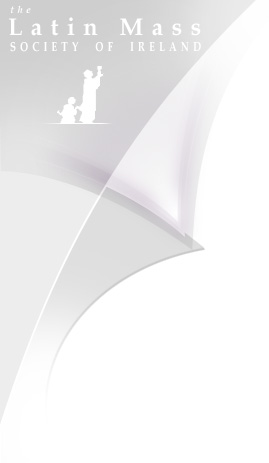
Dom Antoine Forgeot to celebrate a Solemn High Mass in DublinFor the first time in Ireland since the liturgical changes of the 1960s, a mitred abbot is to celebrate a Solemn High Mass in the ancient Latin rite. Dom Antoine Forgeot OSB from Fontgombault Abbey in France will be celebrating the regular indult Mass at St Audoens Church, High St., Dublin at 11 o'clock on Sunday July 25. Fontgombault is one of several monasteries in France which now celebrate the Mass and Divine Office according to the old liturgical books of 1962. In common with the rest of these traditional monasteries, it has no vocations crisis. The number of monks continues to grow year by year, and has now reached around 60. It has several daughter houses in France, and one at Clear Creek, Oklahoma. Chequered history Fontgombault is one of the oldest religious foundations in the world, with a chequered history stretching back over 1,000 years. In the 10th or 11th century, a hermit by the name of Gombaud came to live in a grotto beside the River Creuse near a fountain which was called after him, "Font-GombaudÓ. By the end of the 11th century, this hermitage had expanded into a community of monks under the direction of Pierre de l'Etoile, who in 1091 set out to erect a Benedictine monastery beside the river. Construction of the Abbey continued after Pierre's death (1114) and by 1141 the Abbey church was ready to be consecrated. The rest of the impressive buildings were completed by the beginning of the 13th century. The Abbey of Fontgombault suffered serious setbacks after its initial period of growth. Though it had been fortified with moats and walls, the Abbey was sacked during the Hundred Years War between France and England, and burned by Calvinists in 1569. Worldly abbots Even more disastrous was the French kings' practice of appointing abbots who collected sizeable revenues from the Abbey without being concerned for the spiritual life of the community. In the 17th century, the Abbey's fortunes changed again under prior Nicholas Andrieu. At the time of Dom Nicholas' death in 1705, the Abbey enjoyed a reputation for fervour, discipline, and the regularity of its monastic life. Unfortunately Dom Andrieu's revival was only short-lived and the Benedictine community was suppressed in 1741. During the French Revolution, Fontgombault became State Property and was sold in 1791. The site was used as a stone quarry and the picturesque ruins became a local picnic site. In 1850, the Abbe Lenoir, a diocesan priest from Bourges (the diocese in which Fontgombault is situated) undertook the restoration of the ancient buildings. Trappist monks from Bellefontaine and Melleray (original mother house of Mount Melleray in Co. Waterford) took up residence; but a series of anti-clerical laws introduced by a French government dominated by Freemasons forced them to disperse in 1903. Fontgombault was definitively restored in 1948 when monks from Solesmes re-established contemplative Benedictine life according to the ideals of Dom Gueranger, whose lifelong work was to preserve the Church's liturgical chant. The monastery was raised to the rank of Abbey on August 15, 1953 and the restored church was consecrated in 1954. The monastic vocation Here are some of Dom Antoine's thoughts on the subject of monasticism: "What are the essentials of a monastic vocation? St Benedict enumerates in his Rule the criteria for a monastic vocation: truly seek God and be eager for obedience and humiliation. The contemplative monastic vocation is a call?to follow Christ Who became obedient all the way to death on the Cross, to enter into His prayer, to be attentive to the things of God by spiritual reading and study, to live in charity. As St Therese said, to love is to give everything and to give yourself..." "The crisis of vocations to the priesthood must not put into question the existence of contemplative monasteries. I would say, to the contrary, that this crisis demands the existence of such monasteries..." Perhaps we should be praying for the establishment of a traditional Benedictine monastery in Ireland? Nick Lowry |